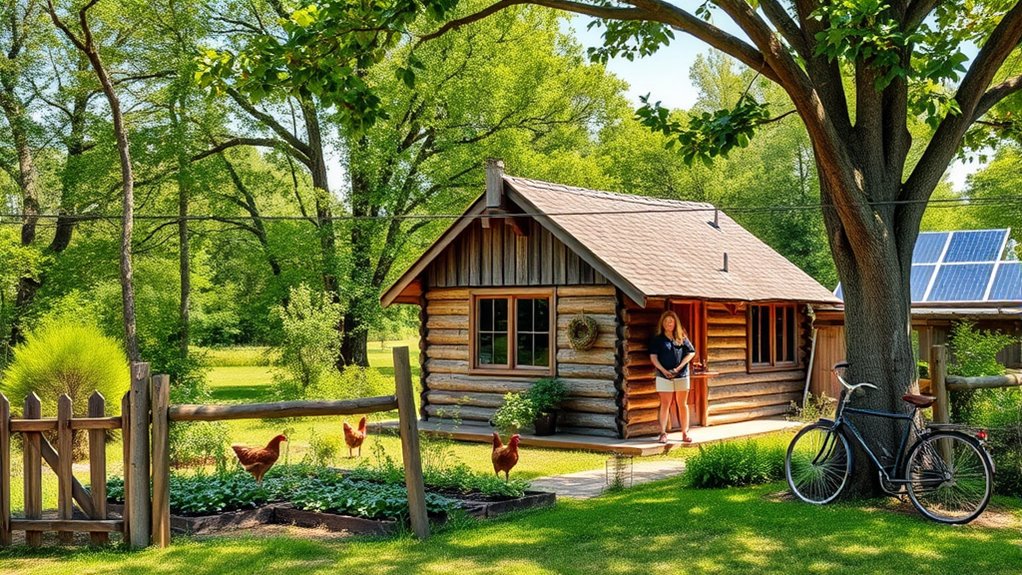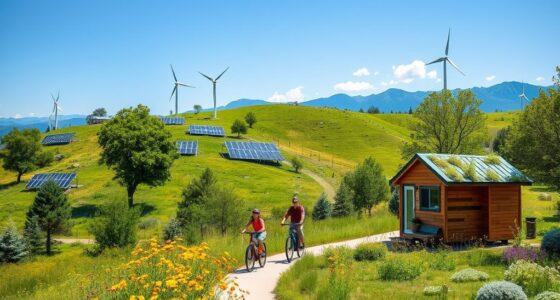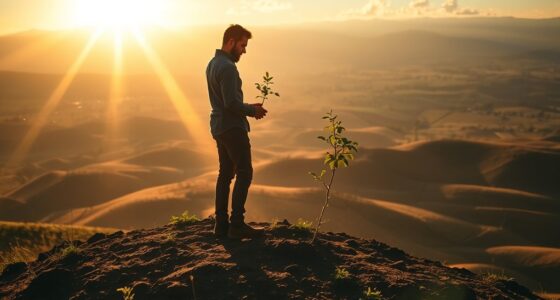Discover how this family fully embraces off-grid living by choosing the right location with mild climate and ample natural resources. They build eco-friendly homes, harness renewable energy like solar and wind power, and develop reliable water and waste systems. Daily routines include gardening, collecting water, and engaging with neighbors for support. Their journey shows how preparation, flexibility, and community help make off-grid life sustainable and joyful. Continue exploring to learn more about their inspiring lifestyle.
Key Takeaways
- The family has achieved full self-sufficiency through sustainable practices like renewable energy, water collection, and eco-friendly construction.
- They selected a moderate, sunny location with reliable water sources and minimal regulatory restrictions for off-grid living.
- Their home design emphasizes energy efficiency, passive solar heating, and natural materials to reduce environmental impact.
- Daily routines include water management, gardening, and community engagement, fostering independence and local support.
- Overcoming challenges with resource management and technology, they enjoy benefits like resilience, cost savings, and a closer connection to nature.
The Family’s Journey to Self-Sufficiency

The family’s journey to self-sufficiency begins with a clear vision of independence and resilience. You start by defining what self-sufficiency means for your family—be it growing your own food, generating your own power, or managing water sources. Next, you research suitable locations, considering climate, land costs, and legal regulations. Planning is essential; you set goals for your sustainable lifestyle and gather the necessary skills, like gardening, solar setup, and basic construction. You then acquire land, build essential infrastructure, and implement renewable energy systems. Throughout this process, you remain adaptable, learning from challenges and refining your approach. This journey is about creating a life where you rely on your own resources, fostering freedom, resilience, and a deep connection with your environment. Understanding the importance of projector technology can also inspire innovative solutions for creating the perfect home theater setup in your off-grid lifestyle, especially as remote work can sometimes be integrated into off-grid living for added flexibility. Additionally, considering investment diversification strategies such as precious metals can provide financial security for your self-sufficient life. Emphasizing community connections can also enhance resource sharing and support during your off-grid journey. For example, exploring nearby water parks can offer recreational opportunities without relying on extensive infrastructure, supporting your goal of independence and self-sufficiency.
Choosing the Perfect Off-Grid Location

When choosing your ideal off-grid location, consider how the climate matches your lifestyle and energy needs. Accessibility to land and resources can make or break your plans, so look for areas with straightforward land access. Don’t forget to check the local regulations, as rules vary widely and can impact your ability to live freely and sustainably. Conducting thorough market research can help you understand regional trends and legal requirements, ensuring your off-grid lifestyle aligns with your goals. Additionally, assessing the availability of fresh water in the area is crucial for maintaining a sustainable and self-sufficient living situation. Exploring cost and budgeting options, including land acquisition and infrastructure expenses, can help you plan realistically and avoid unexpected financial challenges. Understanding legal considerations related to property and resource use is also essential to prevent future conflicts and ensure compliance with local laws. Being aware of environmental restrictions can further influence your choice of location and ensure your off-grid setup remains compliant.
Climate Compatibility
Choosing the right climate is essential for off-grid living because it directly impacts your ability to grow food, maintain energy systems, and stay comfortable year-round. Moderate climates with distinct but manageable seasons help you grow a variety of crops without extreme weather challenges. Mild winters reduce the need for extensive heating, saving energy and costs. Consistent sunlight supports solar power efficiency, while moderate precipitation ensures reliable water sources without severe droughts or flooding. Cold or very hot environments can complicate energy use and food production, increasing your workload. Climate also influences the durability of your structures and equipment. Picking a location with a stable, predictable climate simplifies daily life, making it easier to sustain your off-grid home comfortably and efficiently. Incorporating climate compatibility considerations such as temperature ranges and seasonal variability further enhances your off-grid success. Additionally, understanding weather patterns can help you prepare for unexpected climate shifts that might affect your homestead. Being aware of microclimates within your chosen area can also provide strategic advantages for placement of your home and gardens. Recognizing environmental resilience can help you select locations less prone to natural disasters, ensuring long-term sustainability. Considering seasonal variability helps in planning for crop cycles and energy needs throughout the year.
Land Accessibility
Securing accessible land is a critical step in establishing an off-grid lifestyle that aligns with your needs and goals. You want to find land with reliable road access, especially during harsh weather, so you’re not stranded. Look for properties near existing infrastructure to avoid costly upgrades. Consider the terrain—flat land simplifies building and farming, but hilly areas may offer better water catchment and privacy. Check for proximity to natural water sources, such as streams or lakes, which are essential for self-sufficiency. Research local land prices and availability; states like Iowa and Texas offer affordable options. Confirm land use restrictions are minimal or compatible with your plans. Ultimately, choose a location that provides easy access, suitable terrain, and aligns with your vision for off-grid living. Additionally, vetted options for off-grid properties can help identify areas with established communities and resources.
Regulatory Environment
Understanding the regulatory environment is crucial when selecting an off-grid location, as laws and restrictions can greatly impact your ability to live sustainably and independently. Some states have minimal regulations, offering more freedom to set up water, septic, and renewable energy systems without interference. For example, states like Oklahoma and Kansas have low restrictions and no caps on homestead tax exemptions, easing financial burdens. Conversely, states like California enforce stricter rules on land use, water rights, and renewable installations, which can complicate off-grid plans. It’s essential to research local zoning laws, building codes, and utility regulations before choosing your site. Knowing these details upfront helps you avoid legal issues, ensures compliance, and makes your off-grid dream a sustainable reality. Additionally, understanding regulatory flexibility can help you select a location that aligns with your sustainable living goals. Being aware of zoning laws and how they vary across regions can further streamline your planning process and prevent potential setbacks. Recognizing the importance of community acceptance and social dynamics can also aid in understanding community acceptance of off-grid living.
Building a Sustainable Home From Scratch

Building a sustainable home from scratch requires careful planning and a focus on eco-friendly practices. First, choose a site with minimal environmental impact, ideally with access to natural resources like water and sunlight. Use locally sourced, sustainable materials such as reclaimed wood or straw bale insulation. Design your home to maximize energy efficiency—opt for passive solar heating, natural ventilation, and compact layouts to reduce heating and cooling needs. Incorporate eco-friendly systems like composting toilets and rainwater harvesting to minimize utility reliance. Build with renewable energy in mind, ensuring your home can support solar panels or wind turbines in the future. Prioritize durability and low-maintenance features to extend your home’s lifespan and reduce resource consumption over time. Utilizing low light office plants can also improve indoor air quality while requiring minimal care. Additionally, implementing energy-efficient appliances can further reduce your overall environmental footprint and operational costs. Incorporating smart home technology with integrated AI security can help safeguard your energy systems and smart devices from cyber threats, ensuring your off-grid lifestyle remains secure. To enhance resilience, consider integrating backup power solutions such as solar batteries or microgrids to ensure continuous power availability during inclement weather or system maintenance.
Powering up With Renewable Energy

Have you considered how renewable energy can transform your off-grid lifestyle? Embracing sustainable power sources reduces reliance on external utilities and lowers your environmental impact. To get started, focus on these key options:
- Solar Power: Install panels to convert sunlight into electricity, ideal for most locations.
- Wind Turbines: Use wind energy where gusts are consistent, supplementing solar power.
- Hydropower: Harness nearby streams or rivers for continuous, reliable energy.
- Biomass Systems: Convert organic waste into fuel, supporting off-grid heating and power needs.
Water and Waste Management Systems

Renewable energy systems play a pivotal role in powering your off-grid home, but managing water and waste is equally important for sustainable living. You typically gather water from rain catchment systems, wells, or nearby streams, ensuring a reliable supply. Filtration and purification are essential to make this water safe for drinking and cooking. For waste, you might use composting toilets, which turn human waste into compost without water, or install septic systems suited for off-grid setups. Greywater from sinks and showers can be recycled for irrigation with proper filtration. Proper waste management prevents contamination and preserves your environment. Regular maintenance keeps these systems functioning effectively, ensuring your off-grid lifestyle remains eco-friendly, self-sufficient, and safe for your family.
Daily Life and Community Connections
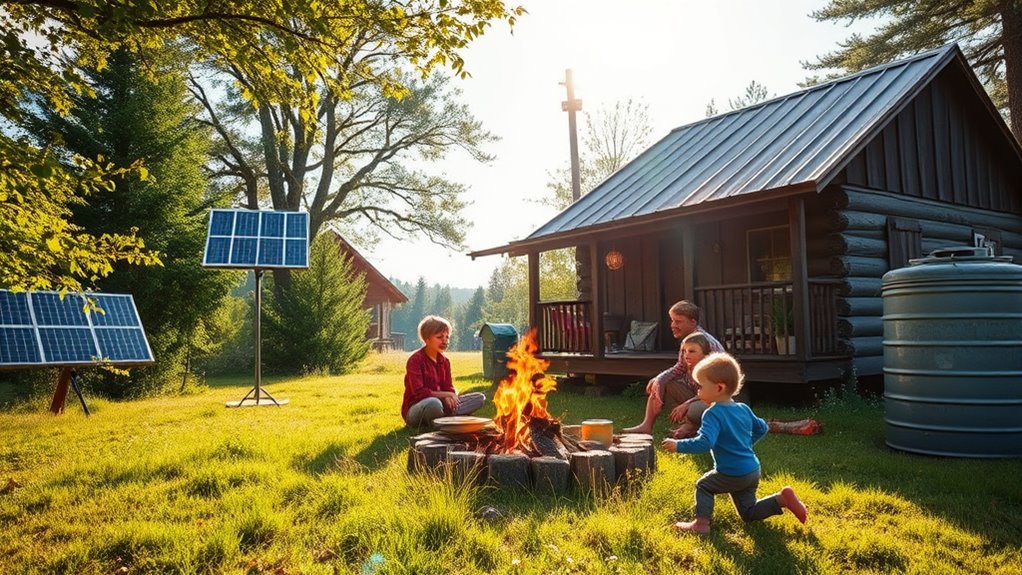
Living off-grid often means developing a daily routine that balances self-sufficiency with community involvement. You start your mornings with chores like collecting water, tending to your garden, or maintaining solar panels. Staying connected with neighbors is crucial, whether through shared food, bartering, or community events. Your day might include:
Balancing self-sufficiency with community bonds sustains off-grid life.
- Participating in local barter markets or skill exchanges
- Attending community gatherings or work parties
- Sharing resources like tools or produce with neighbors
- Collaborating on sustainable projects or communal tasks
These connections foster a sense of belonging and support, essential for off-grid life. While you cherish independence, knowing your community is nearby offers reassurance and shared strength. This balance keeps your lifestyle sustainable, meaningful, and deeply rooted in mutual reliance.
Overcoming Challenges of Remote Living
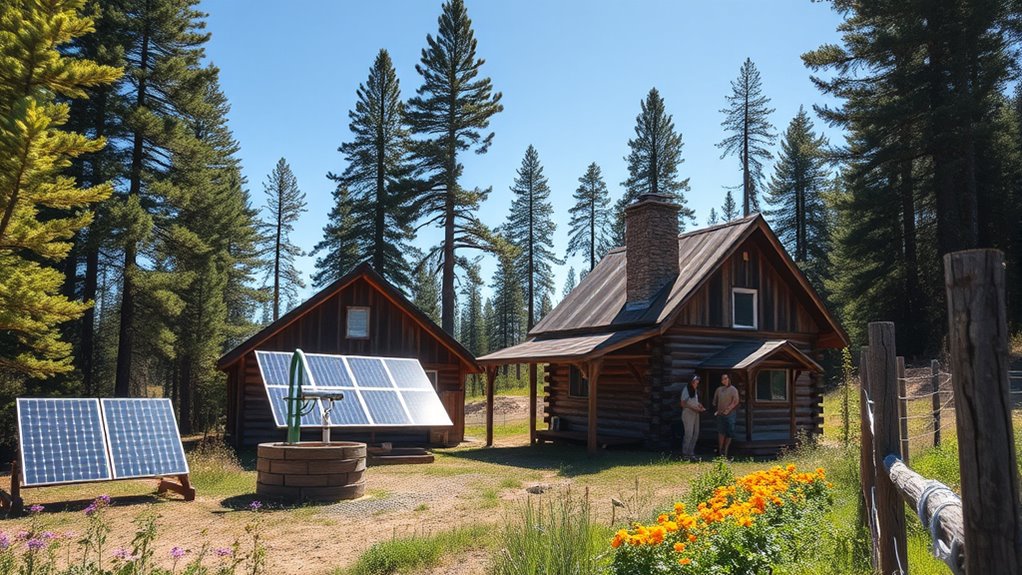
Living off-grid means you need to carefully manage your limited resources to stay self-sufficient. Reliable communication can be tricky, but with the right technology, you can stay connected even in remote areas. Addressing these challenges head-on helps you build a sustainable and resilient lifestyle.
Managing Limited Resources
Facing limited resources in remote living requires resourcefulness and careful planning. You need to maximize what you have and adapt quickly to challenges. To do this effectively, consider these strategies:
- Prioritize resource conservation by implementing strict water, energy, and food rationing.
- Utilize renewable energy sources like solar panels to reduce reliance on external power.
- Develop multiple water collection methods, such as rainwater harvesting and well sources.
- Grow a diverse garden to ensure a steady food supply and reduce dependency on store-bought items.
Ensuring Reliable Communication
Remote living often presents communication challenges because cell service and internet access can be unreliable or unavailable. To stay connected, you can set up alternative solutions. Satellite internet, like Starlink, offers high-speed connectivity even in remote areas. You might also consider radio communication systems or ham radios for emergency contact. These options assure you’re reachable when needed. Here’s a quick look at some tools:
| Device | Purpose |
|---|---|
| Satellite internet | Reliable high-speed connection |
| Ham radios | Emergency communication |
| Cell boosters | Improve weak cell signal |
| Wi-Fi extenders | Expand limited internet coverage |
| Mobile hotspots | Portable internet access |
Combining these tools helps you overcome isolation, keeping you connected to family, emergency services, and the outside world.
The Environmental Impact of Off-Grid Living

Off-grid living can considerably reduce your environmental footprint by decreasing reliance on fossil fuels and traditional utility systems. You cut down on greenhouse gas emissions and lessen strain on local resources. To maximize your positive impact, consider:
- Installing solar or wind power to generate clean energy.
- Collecting rainwater and using composting toilets to minimize water use and waste.
- Growing your own food to reduce transportation emissions.
- Using sustainable building materials to lower your carbon footprint during construction.
These practices promote a more eco-friendly lifestyle by conserving water, reducing waste, and harnessing renewable energy. Your efforts contribute to a healthier planet while fostering resilience and self-sufficiency. Off-grid living isn’t just about independence—it’s about actively protecting the environment.
Tips for Aspiring Off-Grid Families
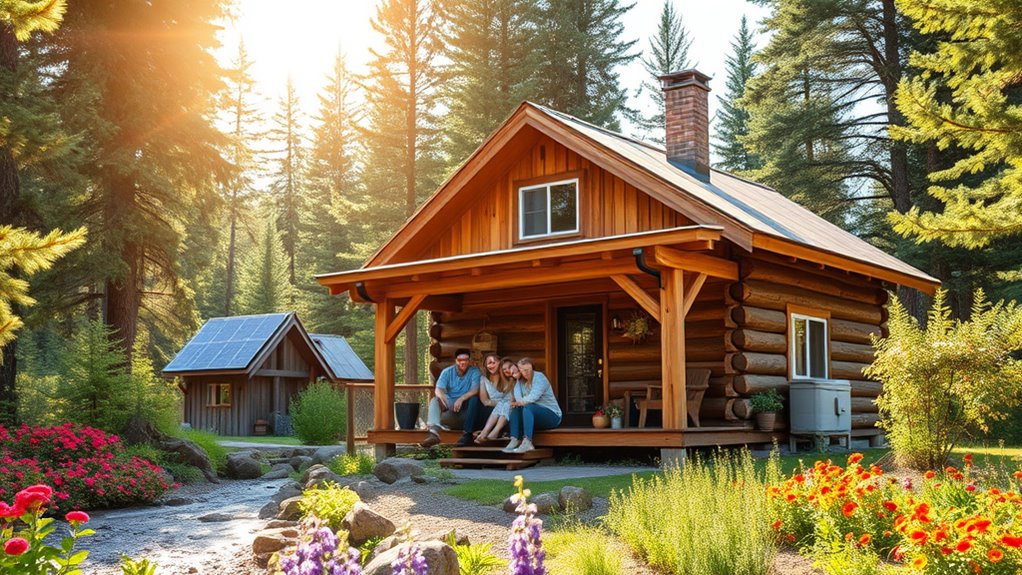
Preparing for off-grid living starts with thorough planning and research. Begin by choosing a suitable location, considering climate, legal restrictions, and access to resources. Next, evaluate your energy needs and explore renewable options like solar or wind power. Assess water sources—whether wells, rain collection, or nearby streams—and plan for wastewater management, such as septic systems. Budget realistically for land, infrastructure, and equipment, keeping costs in mind. Develop a skills plan, including gardening, carpentry, and basic repairs, to reduce reliance on external help. Connect with existing off-grid communities or online groups for insights and support. Finally, start small—test systems and routines before fully moving off-grid—so you can adapt and troubleshoot early on. Proper preparation sets a strong foundation for your off-grid journey.
Frequently Asked Questions
How Do Off-Grid Families Access Healthcare and Emergency Services?
You can access healthcare and emergency services by planning ahead, establishing connections with local clinics or telemedicine providers, and knowing your nearest emergency facilities. Keep a well-stocked first aid kit and make certain your communication tools, like satellite phones or radios, are functional. Building relationships with nearby neighbors or off-grid communities also helps, so you’re prepared and connected when urgent situations arise. Proper planning ensures your safety and health off-grid.
What Are Legal Considerations for Establishing an Off-Grid Homestead?
When establishing an off-grid homestead, you need to research state and local laws carefully. Check for restrictions on building codes, water rights, and septic systems. Some states have low or no restrictions, making it easier, while others enforce strict regulations. You’ll also want to comprehend property tax exemptions and zoning laws. Consulting with legal experts or local authorities beforehand prevents surprises and guarantees your homestead complies with all requirements.
How Do Off-Grid Families Handle Education and Schooling?
Over 11 states have low homeschool regulations, making off-grid families‘ education easier to manage. You can often educate your children at home without notifying the state or meeting strict requirements. Many families use homeschooling, unschooling, or community-based education, focusing on personalized learning. This flexibility helps you tailor your child’s education to your values and lifestyle, ensuring they receive a quality education while living off the grid.
What Financial Costs Are Involved in Starting Off-Grid Living?
You’ll face initial costs like land, which can range from $5,000 to $50,000 depending on location. Solar power systems cost around $45,000 to $65,000, water setup $3,000 to $15,000, and septic systems $500 to $5,000. Building an off-grid cabin might set you back $20,000 to $50,000. Ongoing expenses include maintenance, renewable energy upgrades, and possible regulatory fees, but overall, costs vary based on your chosen lifestyle and location.
How Do Off-Grid Families Stay Connected and Communicate With the Outside World?
Did you know over 250,000 people in the US live off-grid? You can stay connected through satellite internet, which is reliable even in remote areas, or use mobile hotspots for everyday needs. Ham radios also offer emergency communication, and solar-powered devices keep you connected without grid access. With these options, you maintain communication and stay informed while enjoying your off-grid lifestyle.
Conclusion
So, if you’ve ever dreamed of ditching city noise for the soothing sounds of nature and becoming a full-time hermit, remember: it’s all sunshine and rainbows until you realize you’re also your own plumber, electrician, and therapist. Off-grid living isn’t just a lifestyle; it’s an endless adventure in self-reliance, with a dash of “what could possibly go wrong?” But hey, if they can do it happily, maybe you can too—just don’t forget the bug spray.
